Evening Fires Sweater |
||||||||||||||||
 |
 |
|||||||||||||||
Knitted sweater in 2 strands DROPS Brushed Alpaca Silk or 1 strand DROPS Wish. Piece is knitted with cables and double neck edge. Size: S - XXXL
DROPS 226-40 |
||||||||||||||||
|
---------------------------------------------------------- EXPLANATION FOR THE PATTERN: ---------------------------------------------------------- PATTERN: See diagrams A.1 and A.2. Diagrams show all rows in pattern seen from the right side. INCREASE TIP: Work until 2 stitches remain before marker thread, make 1 yarn over, knit 4 (marker thread is in the middle of these 2 stitches), make 1 yarn over. On next round purl yarn overs twisted to avoid holes = 2 stitches increased. Then purl the new stitches. ---------------------------------------------------------- START THE PIECE HERE: ---------------------------------------------------------- SWEATER - SHORT OVERVIEW OF THE PIECE: Piece is worked in the round on circular needle, from the bottom and up to armholes, then divide the piece and finish front piece and back piece separately. Work sleeves in the round on a short circular needle/double pointed needles, bottom up. BODY: Cast on 112-120-128-136-144-152 stitches on circular needle size 6 MM = US 10 with 2 strands DROPS Brushed Alpaca Silk or 1 strand DROPS Wish. Knit 1 round, then work rib as follows: SIZE S-L-XXL: Knit 1, * purl 2, knit 2 *, work from *-* until 3 stitches remain, purl 2 and knit 1. SIZE M-XL-XXXL: Purl 1, * knit 2, purl 2 *, work from *-* until 3 stitches remain, knit 2 and purl 1. Continue with rib until piece measures 6 cm = 2⅜", switch to circular needle size 8 MM = US 11. Continue as follows: Purl the first 7-9-11-13-15-17 stitches, at the same time decrease 1 stitch over these stitches, A.1 (= 10 stitches that are increased to 15 stitches), purl 6, A.1, purl 6, A.1, purl the next 14-18-22-26-30-34 stitches, at the same time decrease 2 stitches over these stitches, A.1, purl 6, A.1, purl 6, A.1, purl the last 7-9-11-13-15-17 stitches, at the same time decrease 1 stitch over these stitches. When A.1 has been worked 1 time vertically, there are 138-146-154-162-170-178 stitches on needle. Continue with A.2 (= 15 stitches) over every A.1, work the remaining stitches as before. Continue pattern like this. REMEMBER THE KNITTING GAUGE! When piece measures 30-31-32-33-34-35 cm = 11¾"-12¼"-12½"-13"-13⅜"-13¾", divide the piece for front piece and back piece. Work next round as follows: Bind off the first 2 stitches on round for armhole, work 65-69-73-77-81-85 stitches (= front piece), bind off 4 stitches for armhole, work 65-69-73-77-81-85, bind off the last 2 stitches on needle for armhole. Cut the yarn. Each part is worked separately back and forth on needle. Slip the first 65-69-73-77-81-85 stitches on a stitch holder, and then work over the 65-69-73-77-81-85 stitches on back piece. BACK PIECE: = 65-69-73-77-81-85 stitches. Work as follows - from right side: Purl 4-6-8-10-12-14, A.2, purl 6, A.2, purl 6, A.2, purl 4-6-8-10-12-14. When piece measures 49-51-53-55-57-59 cm = 19¼"-20"-21"-21⅝"-22½"-23¼", decrease 5 stitches over middle repetition of A.2, on next row bind off the middle 14-16-18-20-22-24 stitches for neck, and finish each shoulder separately. Then bind off 1 stitch on next row from neck = 22-23-24-25-26-27 stitches. Work the stitches in A.2 in stockinette stitch, decrease at the same time 5 stitches evenly over these stitches = 17-18-19-20-21-22 stitches. Bind off when piece measures 52-54-56-58-60-62 cm = 20½"-21¼"-22"-22¾"-23⅝"-24⅜" (= 22-23-24-25-26-27 cm = 8¾"-9"-9½"-9¾"-10¼"-10⅝" from division for armholes). Work the other shoulder the same way. FRONT PIECE: = 65-69-73-77-81-85 stitches. Work as follows - from right side: Purl 4-6-8-10-12-14, A.2, purl 6, A.2, purl 6, A.2, purl 4-6-8-10-12-14. When piece measures 46-48-50-52-54-56 cm = 18"-19"-19¾"-20½"-21¼"-22", decrease 5 stitches over the middle repetition of A.2, on next row slip the middle 8-10-12-14-16-18 stitches on a stitch holder for neck, and finish each shoulder separately. Then bind off stitches on every row from neck as follows: Bind off 2 stitches 1 time and 1 stitch 2 times = 22-23-24-25-26-27 stitches. Work the stitches in A.2 in stockinette stitch, decrease at the same time 5 stitches evenly over these stitches. Bind off when piece measures 52-54-56-58-60-62 cm = 20½"-21¼"-22"-22¾"-23⅝"-24⅜" (= 22-23-24-25-26-27 cm = 8¾"-9"-9½"-9¾"-10¼"-10⅝" from division for armholes). Work the other shoulder the same way. SLEEVE: Work sleeves in the round on double pointed needles/a short circular needle bottom up. Cast on 32-32-36-36-40-40 stitches on double pointed needles size 6 MM = US 10 with 2 strands Brushed Alpaca Silk or 1 strand DROPS Wish. Knit 1 round, then work rib as follows: SIZE S-M-XXL-XXXL: Knit 1, * purl 2, knit 2 *, work from *-* over the next 30-30-38-38 stitches, finish with knit 1. SIZE L-XL: Purl 1, * knit 2, purl 2 *, work from *-* over the next 34-34 stitches, finish with purl 1. Work rib for 6 cm = 2⅜", switch double pointed needles size 8 MM = US 11. Work next round as follows: Purl the first 11-11-13-13-15-15 stitches, at the same time increase 3-4-3-4-3-4 stitches evenly over these stitches, A.1, purl the last 11-11-13-13-15-15 stitches, at the same time increase 3-4-3-4-3-4 stitches evenly over these stitches. When A.1 has been worked 1 time vertically and the increases have been done evenly, there are 43-45-47-49-51-53 stitches on needle. Continue with A.2 over stitches in A.1 and purl as before. Insert a marker thread at beginning of round = mid under sleeve. When piece measures 8 cm = 3⅛", increase 1 stitch on each side of marker thread - read INCREASE TIP. Increase every 9-9-9-8-8-8 cm = 3½"-3½"-3½"-3⅛"-3⅛"-3⅛" 5 times in total in every size = 53-55-57-59-61-63 stitches. When sleeve measures 49-48-47-46-45-44 cm = 19¼"-19"-18½"-18"-17¾"-17¼", work sleeve cap back and forth (from mid under sleeve) on circular needle until finished measurements. When piece measures 50-49-48-47-46-45 cm = 19¾"-19¼"-19"-18½"-18"-17¾", decrease 5 stitches evenly over stitches in A.2. Work until sleeve measures approx. 51-50-49-48-47-46 cm = 20"-19¾"-19¼"-19"-18½"-18", i.e. there is a vent of 2 cm = ¾" at the top of sleeve. Work another sleeve the same way. ASSEMBLY: Sew the shoulder seams. Sew sleeve cap to armhole. Then sew vent at the top of sleeve to bottom of armhole - see chart. NECK EDGE: Begin from right side at one shoulder seam and pick up approx. 44-60 stitches around the neck, including stitches from stitch holder at the front (number of stitches should be divisible by 4) on a short circular needle size 6 MM = US 10 with 2 strands Brushed Alpaca Silk or 1 strand DROPS Wish. Work rib (= knit 2/purl 2) for 12 cm = 4¾". Bind off stitches with knit over knit and purl over purl. Fold rib at the top of neck down on inside of garment. Fasten rib to get a double neck edge. To avoid a tight neck edge that sticks out it is important to keep the seam elastic. |
||||||||||||||||
Diagram explanations |
||||||||||||||||
|
||||||||||||||||

|
||||||||||||||||
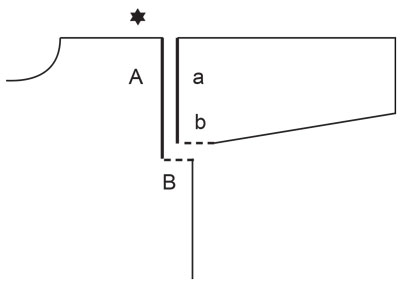
|
||||||||||||||||
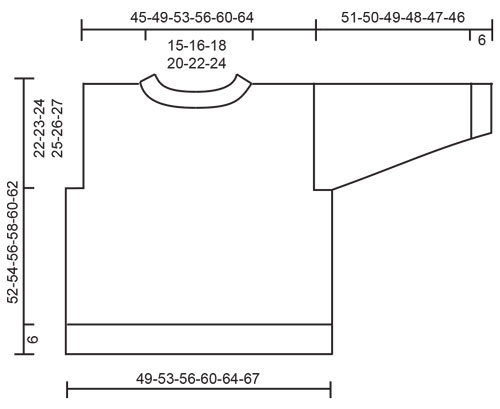
|
||||||||||||||||
|
Have you made this or any other of our designs? Tag your pictures in social media with #dropsdesign so we can see them! Do you need help with this pattern?You'll find tutorial videos, a Comments/Questions area and more by visiting the pattern on garnstudio.com. © 1982-2024 DROPS Design A/S. We reserve all rights. This document, including all its sub-sections, has copyrights. Read more about what you can do with our patterns at the bottom of each pattern on our site. |
||||||||||||||||








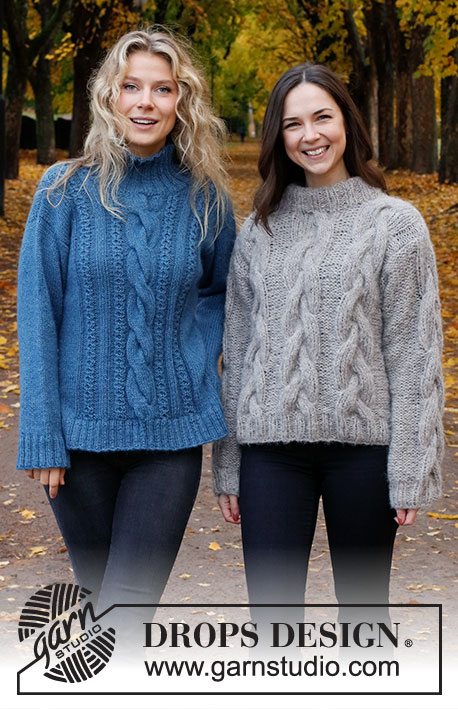



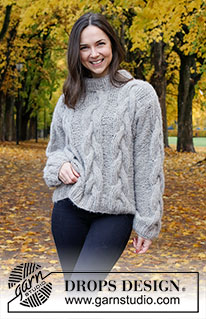


















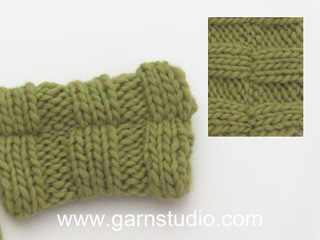





























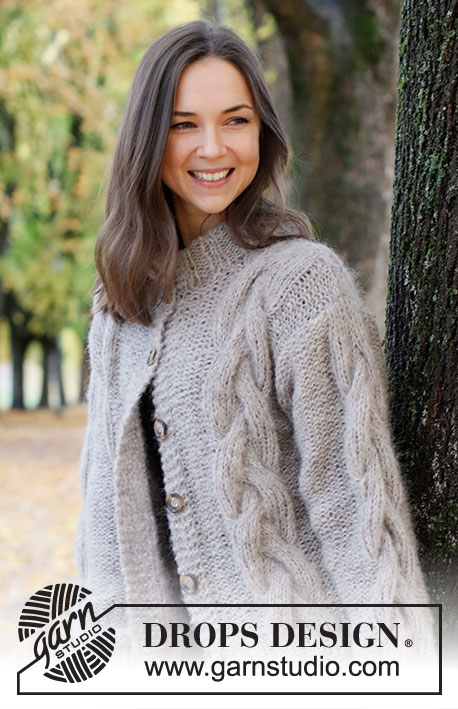






Comments / Questions (15)
Kan ik de sweater, en andere sweaters ook trouwens, zonder de dubbele kraag maken? Alvast bedankt!
02.08.2023 - 23:24DROPS Design answered:
Dag Nisa,
Ja dat kan! Je breit de hals dan gewoon de helft minder hoog.
03.08.2023 - 21:06Thank you the lovely desig which I just started knitting in size XXL, I have read the instructions over and over but I cannot understand one thing. I am knitting the rib section ans I have 144 sts as per pattern, reading the following sections how is it we need to Decrease and still have more sts on our needles? ie: 170 sts where did we get the extra 26 sts if no increases needed. I appreciate your reply thank you. (I am knitting it for somebody else si it will have to be perfect). xxx Eva
13.06.2023 - 15:23DROPS Design answered:
Dear Eva, note that when working 1st row in A.1 you will increase 5 stitches in each A.1 (see the 5 yarn overs), so that you will work as follows: Purl 15 sts decreasing 1 (= 14 sts), A.1 (= 10 sts increased to 15 sts), purl 6, A.1 (10 sts increased to 15 sts), purl 6, A.1 (10 sts increased to 15 sts), purl 30 sts decreasing 2 sts (= 28 sts), A.1 (10 sts increased to 15), purl 6, A.1 (10 sts increased to 15), purl 6, A.1 (10 sts increased to 15), purl 15 sts decreasing 1 st (= 14 sts) = 14+15+6+15+6+15+28+15+6+15+6+15+14=170 stitches. Happy knitting!
13.06.2023 - 16:11Hallo! Auf einem der Beispielfotos ist ein blauer Pullover zu sehen. Welche Wolle wurde dafür verwendet und welche Anleitung? Ich würde gerne beide stricken aber finden den blauen nirgendwo. Liebe Grüße
23.11.2022 - 10:28DROPS Design answered:
Liebe Nina, der blaue Pullover wird mit Flora und Kid-Silk gestrickt, den finden Sie hier. Viel Spaß beim stricken!
23.11.2022 - 15:41Dobrý den, jestě jsem se vás ptala na spotřebu příze. Potřebuji na svetr 15 klubíček 50 g Alasky? Děkuji.
21.04.2022 - 13:50DROPS Design answered:
Dobrý den, Aleno, podle našeho převodníku budete potřebovat 1500g příze Alaska. Pokud máte obavu z pletení dvojitou přízí, můžete přízi DROPS Brushed Alpaca Silk nahradit také naší báječnou přízí DROPS Melody nebo DROPS Wish. Ať se daří!
23.04.2022 - 08:06Dobrý den, psala jsem vám dva vzkazy 24.3. a zatím neznám odpovědi. Můžu ještě doufat, že mi odpovíte? Děkuji. Alena
09.04.2022 - 19:25Dobrý den, moc ráda bych si upletla svetr Evening Fires, ale ještě mi není jasný vzor F1. Ten malý nákres. Mohla bych k tomu dostat podrobnější vysvětlení? Děkuji. Alena
24.03.2022 - 19:57DROPS Design answered:
Dobrý den, Aleno, vzor A.1 čtete zprava doleva a zdola nahoru; tj. upletete 2 oka hladce, 1x nahodit, 1x hladce, 1x nahodit, 2x hladce, 1x nahodit, 2x hladce, 1x nahodit, 1x hladce, 1x nahodit, 2x hladce. V následující řadě upletete nahozená oka za zadní nit, aby se netvořily dírky. Potom postupujete dále podle návodu. Hodně zdaru!
23.04.2022 - 07:43Dobrý den, chtěla bych vědět jestli můžu nahradit při pletení svetru Evening Fires vlnu Alpaka Silk vlnou Alaska? U té první vlny se plete dvojitě a také vzor je copánkový, myslim si, že by se to špatně pletlo. Je správná spotřeba 30 klubíček 50 gramové Alasky? Děkuji. Alena
24.03.2022 - 12:55DROPS Design answered:
Dobrý den, Aleno, ano, přízi nahradit můžete, ale počítejte s tím, že výsledný vzhled bude trochu jiný - svetr bude hutnější a bude působit rustikálnějším dojmem.
21.04.2022 - 12:34Dobrý den ještě bych chtěla vědět, jestli mi opravdu stačí na svetr Evening Fires pro velikost XXL příze DROPS ALPAKA SILK 15, barvy sv. tyrkysové - příze C, 375 g i když ji použiji dvojitou? Děkuji. Alena
21.03.2022 - 16:03DROPS Design answered:
Dobrý den, Aleno, ano, tato spotřeba by měla být dostačující. Příze DROPS Brushed Alpaca Silk je lehoučká a dodáváme ji v klubíčkách po 25 g s návinem 140 m - 15 klubíček by vám tedy mělo stačit i při pletení dvojitou přízí. Hodně zdaru! Hana
23.03.2022 - 18:19Dobrý den, u návodu na svetr Evening Fires mi není jasné ujimání 5 ok prostřední sekvence vzoru A2? Mohla bych k tomu dostat nějaké podrobnější vysvětlení. Děkuji. Alena
21.03.2022 - 15:40DROPS Design answered:
Dobrý den, Aleno, při tvarování průkrčníku potřebujeme ujmout uprostřed dílu 5 ok. Uprostřed dílu ale leží silný copánek a kdybychom ujmuli všech 5 ok vedle sebe, vznikla by nevzhledná "kapsa", proto je lepší ujímání rozložit nad celou sekvenci, např. takto: 1 oko upleteme, 2 oka spleteme, 1 upleteme, 2 spleteme, atd. Hodně zdaru! Hana
23.03.2022 - 18:42What size knitting needles are used for the gauge?
08.03.2022 - 01:44DROPS Design answered:
Hei Erin, The size 8 mm needles are used for the guage. Happy knitting!
08.03.2022 - 06:58